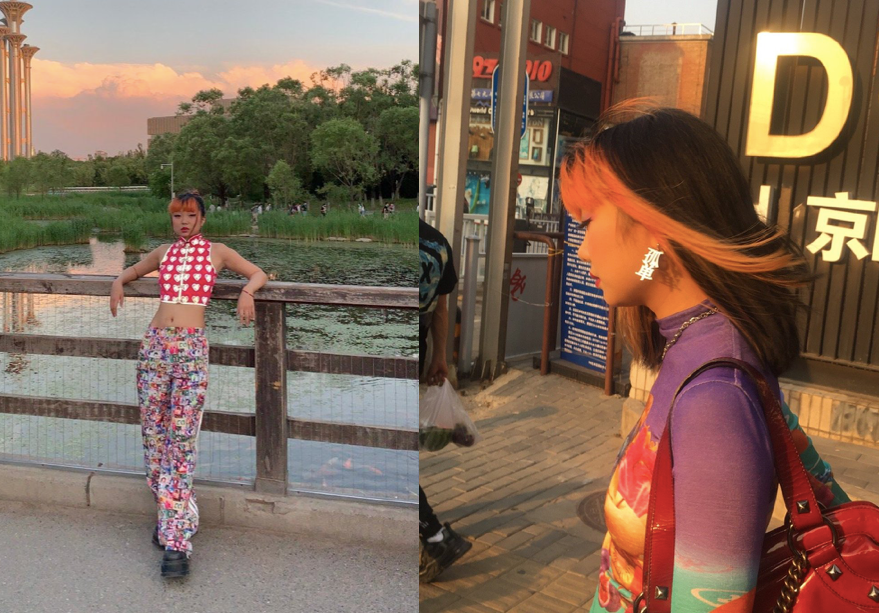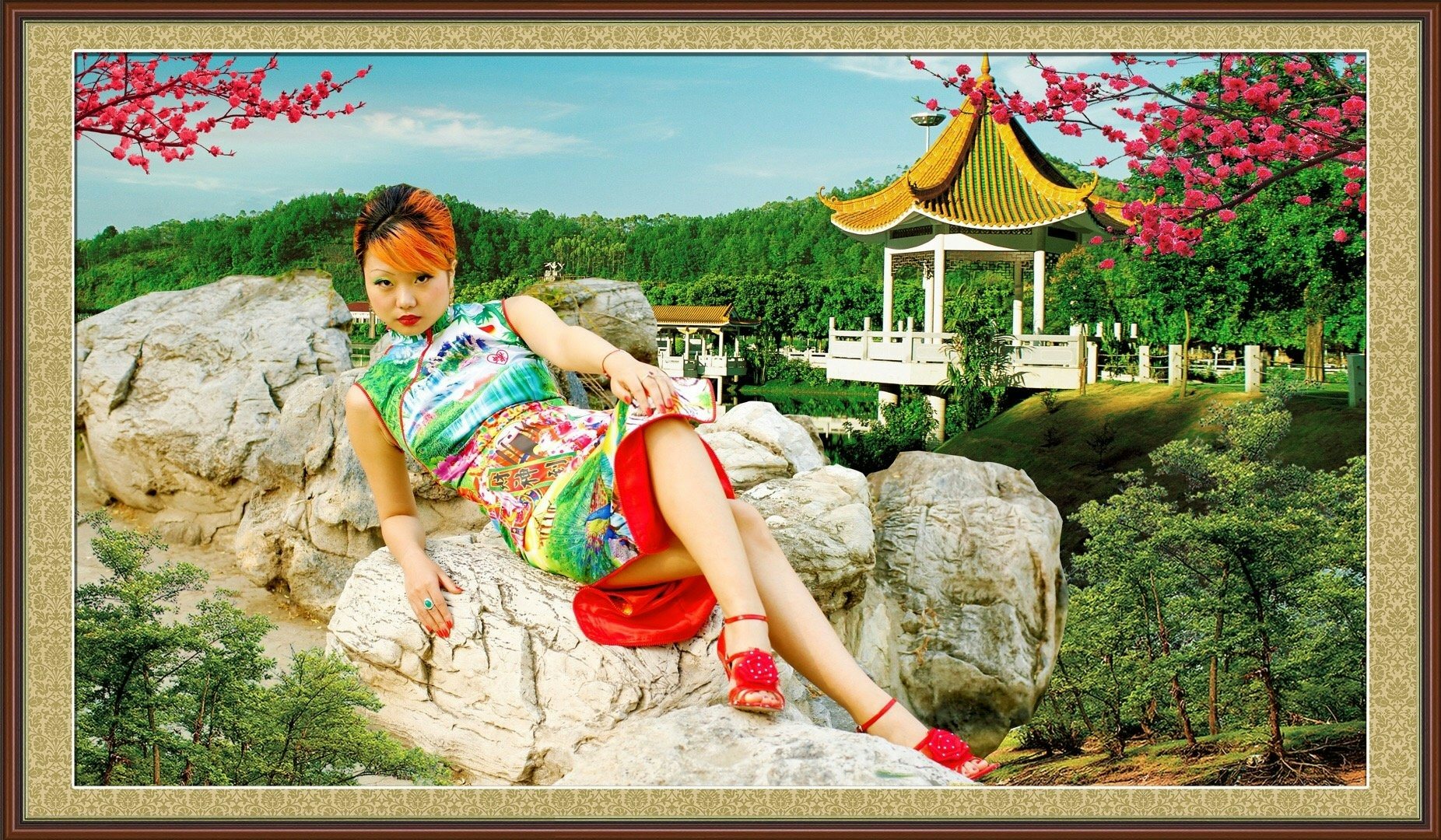In a campaign for her latest design, 22-year-old Liu Min leans on a bed of rocks with legs crossed, sporting a Qipao, a body-hugging dress colorful traditional elements like temples, eagles, and a female Buddha. To her 100,000 followers across different platforms, she is one of the thought leaders of the “Too Cool” movement. While the definition of the phrase “Too Cool” is still being considered by the likes of Lin and the youth who embody it, “Tu” (土, literally translated as “soil”) is one word being used to describe this traditional, rural look.
“Tu” has mainstream connotations of rural tastelessness, and has historically been used to show contempt towards China's rural population. However, it has recently started to gain positive traction among younger fans: on Weibo, young girls happily label themselves as #toocool and #toocoolgirl — the two hashtags have received millions of views collectively. Video streaming platform Bilibili hosts hundreds of “Too cool” videos giving styling tips.
Chinese millennials and Gen-Zers like “Butterfly Princess” Lin are more inclusive of diverse standards of beauty, no longer think of fashion in antonyms like “tu” or “yang” (洋, meaning ‘Western’).
In recent years, there are signals from the top that the government wants its nationals to splurge on China-made and China-designed goods — Shanghai’s first “national hip” shopping festival this year is a prime example. While “Too Cool” has some overlap here, it belongs to its own tribe: the urban youth who embrace “Too Cool” derive their aesthetic inspiration not just from the past but from a generation they haven’t necessarily interacted with. The symbols favoured by Lin are closely associated with rural peasants considered by the mainstream of having no taste. But now, the tide is turning.
Compared to a Y2K aesthetic in the US or colourful Harajuku style in Japan, Jing Daily explores the “Too Cool” subculture and assesses — where it came from, and where it’s going — from different fashion players and influencers.
A Butterfly Princess#
“Butterfly Princess” Lin is a regular at the capital’s senior disco center, and when she wanders around the Sanlitun shopping district where she is stopped by countless street photographers. On Weibo, she has over 30,000 highly engaged followers — most are post-00s young females. “They want to express themselves freely but their schools or parents are usually too strict to allow them to do that,” said the Beijinger, who also posts short videos on Kuaishou.

According to Liu Min, the terms “Tu” and “Too Cool” aren’t the same and her applications of the terms differ: “What I’m doing is extracting interesting elements from ‘Tu’ for my own projects.” One of her current projects involves her eponymous Taobao store where her visual inspirations stem from old posters featuring “well-meaning” elements such as plum blossom and lotus, as well as a love of ancient proverbs (shown in header image). Here she sells clothes and accessories she would wear herself, stocks Qipao and shirts emblazoned with proverbs ranging in price from $30-$70.
Earlier this month, a user on China’s youth cultural forum Douban posted negatively about “Butterfly Princess.” But her followers were quick to defend her — and the comment was met with overwhelming praise for Liu. One netizen said, “she is one of the first people who did ‘Too Cool’ in China, I know not many people are able to understand her, but it shows her unique personality.” Her, and her store’s popularity are proof that China’s youth is starting to connect with the imagery and symbols associated with its rich and storied past.
Fabric Porn’s humorous designs transcend the style movement#
Another player on the “Too Cool scene” is Xi’an-born founder of label Fabric Porn, Zhao Chenxi, who graduated from the University of California, Davis in 2018. His biggest inspiration comes from cultural symbols from his childhood that he remixes in a tongue and cheek fashion. Indeed, almost everyone who has seen his design would have a chuckle, according to Zhao.
The 25-year-old designer suggests that “Too Cool” represents a cultural phenomenon — from a grassroots level: “‘Cool’ is manifested in the form of luxury and fashion trends, and it usually extends from top-down, whereas ‘Too Cool’ merges with mainstream culture from the bottom-up.” Zhao agrees that while he’s labeled “Too Cool,” his vision goes beyond that. “Chinese people still lack the confidence to be proud of their culture and my primary goal is to change that,” he told Jing Daily. “I design pieces that fuse Chinese cultural, philosophical and ideological elements with western values, and hope that they resonate with people.”

Currently based in Shanghai, Fabric Porn was chosen by Labelhood’s inaugural China Energy project at Italy’s menswear showcasing platform Pitti Uomo last June; Zhao playfully modeled his own design in the brand’s lookbook for the event. Spring 2021 is now being designed and will launch in October. He stated: “The main theme is ‘cyber punk new Chinese,’ and I will make modern adaptations on traditional clothing like Qipao, belly bands and Chinese tunic suits.”
The brand’s collections are highly acclaimed by fashion watchers, but according to the founder, pieces that feature particular symbols like “get certificates” (办证) (stickers and stamps featuring erected by an underground workforce, usually seen in old residential buildings) don’t sell as well as other pieces. To many, the symbols likely bring back memories — and not necessarily good ones.
But Zhao is firmly sticking to his chosen aesthetic, adding: “Many people find it interesting but they don’t want to wear it. From a design perspective we will have to figure out ways to encourage customers to be more willing to dress ‘Too Cool.’”
The natural overlap between the “Too Cool” concept and China’s ‘national hip' trend, which hinges on national pride, is undisputed. Many design elements from designer Kate Han’s brand Mukzin — tigers and traditional proverbs like “Realizing your Ambitions” (大展宏图) — resemble those in ‘Butterfly Princess’ Liu’s clothes. Designer Angel Chen, a self-proclaimed “Dragon Princess” herself, also incorporates dragon patterns in her collection — like Liu sporting her favorite cultural symbols. While ‘national pride’ designs come with a modern twist, for “Too Cool,” the more “Tu” the better.

“We are in a pivotal moment of Chinese youth's aesthetics,” Shanghai-based market research agency Youthology wrote in a recent subscriber newsletter. “‘Too Cool’ has been embraced by young spending powers in first and second-tier cities who don't have the baggage of mainstream aesthetics.” While the absolute definition of the term is still being defined, what is clear is, as Chinese youth gains their cultural confidence, “Too Cool” is here to stay.
